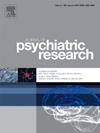了解印尼强迫症患者抑郁和焦虑症状的相互关系:网络方法
IF 3.7
2区 医学
Q1 PSYCHIATRY
引用次数: 0
摘要
强迫症(OCD)患者经常会同时出现抑郁和焦虑症状,这就强调了需要针对重叠症状采取有针对性的临床干预措施。网络分析提供了一种方法来研究症状之间的相互关系,并确定强迫症患者干预的关键症状。本研究收集了印度尼西亚雅加达一家临床心理诊所强迫症门诊患者(232 人)的抑郁(PHQ-9)和焦虑(GAD-7)自我报告数据。我们采用了多种网络分析方法对数据进行了分析,包括关联网络、图形化 LASSO 和有向无环图 (DAG),以直观地显示症状之间的相互关系。研究结果表明,虽然强迫症中的抑郁和焦虑症状各不相同,但它们通过 "桥梁 "症状联系在一起。具体来说,抑郁症的运动症状和焦虑症的不安症状是关键的桥梁,而担忧和紧张则是高度集中性的焦虑症状。相比之下,抑郁症的食欲和自杀症状以及焦虑症的烦躁和恐惧等症状在网络中的联系较少。网络分析突出表明,运动症状可能在维持强迫症患者焦虑和抑郁并发方面起着关键作用。因此,针对运动症状的干预措施(如剧烈运动和行为激活)可能有利于控制这些相互关联的症状并改善患者的预后。本文章由计算机程序翻译,如有差异,请以英文原文为准。
Understanding depression and anxiety symptom interrelations in Indonesian OCD patients: A network approach
Obsessive-compulsive disorder (OCD) patients often experience co-occurring symptoms of depression and anxiety, underscoring the needs for targeted clinical interventions that address overlapping symptoms. Network analysis offers a method to examine the symptom interrelations and identify key symptoms for OCD patients interventions. This study collected self-report data on depression (PHQ-9) and anxiety (GAD-7) on OCD-diagnosed outpatients from a clinical psychology clinic in Jakarta, Indonesia (N = 232). The data were analyzed with several network analysis methods, including association networks, graphical LASSO, and directed acyclic graphs (DAGs), to visualize symptom interrelations. The findings indicated that while depression and anxiety symptoms in OCD are distinct, they are linked by “bridge” symptoms. Specifically, motor symptoms of depression and restlessness symptoms of anxiety were the key bridges, with worry and nervousness identified as highly central anxiety symptoms. In contrast, symptoms like appetite and suicidal symptoms of depression, along with irritability and fear in anxiety, were less connected within the network. Network analysis highlights that motoric symptoms may play a critical role in maintaining co-occurring anxiety and depression in OCD patients. Thus, interventions targeting motoric symptoms—such as intense exercise and behavioral activation—could be beneficial for managing these interconnected symptoms and improving patient outcomes.
求助全文
通过发布文献求助,成功后即可免费获取论文全文。
去求助
来源期刊

Journal of psychiatric research
医学-精神病学
CiteScore
7.30
自引率
2.10%
发文量
622
审稿时长
130 days
期刊介绍:
Founded in 1961 to report on the latest work in psychiatry and cognate disciplines, the Journal of Psychiatric Research is dedicated to innovative and timely studies of four important areas of research:
(1) clinical studies of all disciplines relating to psychiatric illness, as well as normal human behaviour, including biochemical, physiological, genetic, environmental, social, psychological and epidemiological factors;
(2) basic studies pertaining to psychiatry in such fields as neuropsychopharmacology, neuroendocrinology, electrophysiology, genetics, experimental psychology and epidemiology;
(3) the growing application of clinical laboratory techniques in psychiatry, including imagery and spectroscopy of the brain, molecular biology and computer sciences;
 求助内容:
求助内容: 应助结果提醒方式:
应助结果提醒方式:


